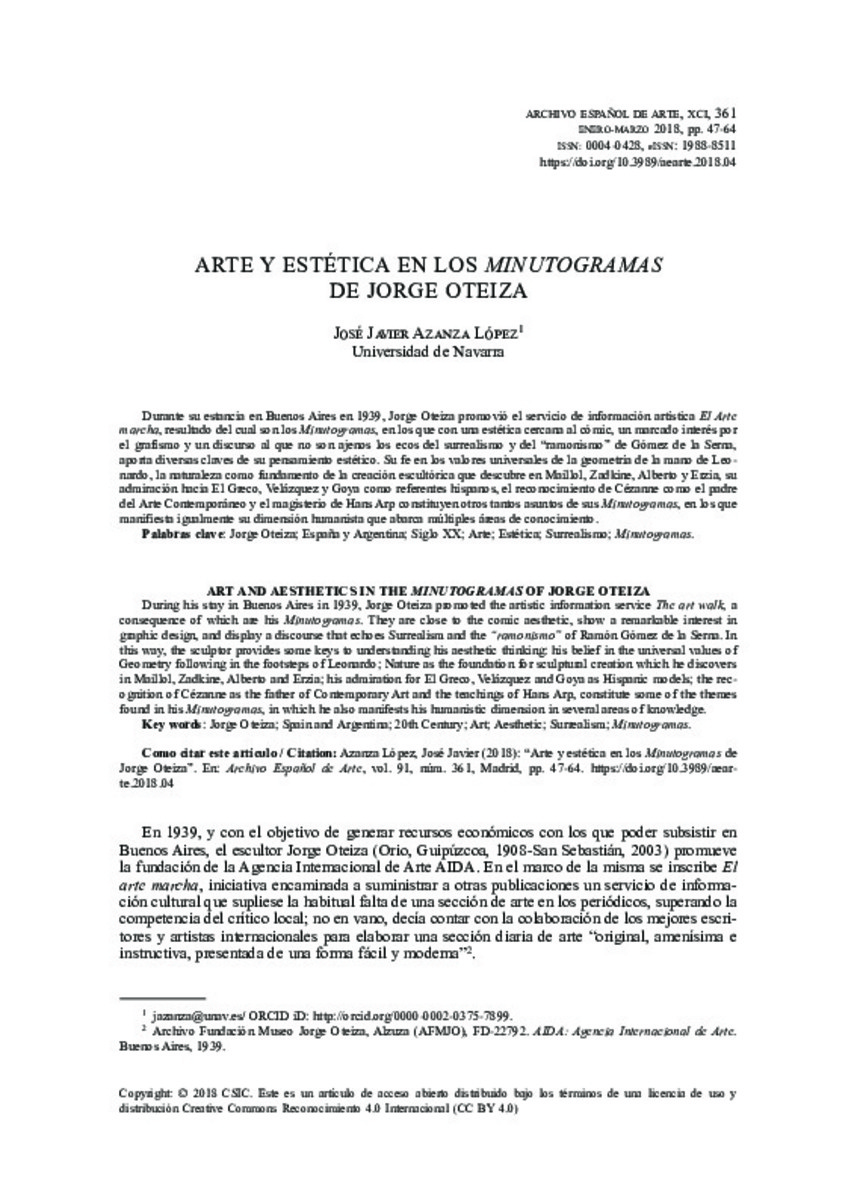Full metadata record
| DC Field | Value | Language |
|---|---|---|
| dc.creator | Azanza-López, J.J. (José Javier) | - |
| dc.date.accessioned | 2020-11-17T14:13:58Z | - |
| dc.date.available | 2020-11-17T14:13:58Z | - |
| dc.date.issued | 2018 | - |
| dc.identifier.citation | Azanza-López, J.J. (José Javier). "Arte y estética en los Minutogramas de Jorge Oteiza". Archivo Español de Arte. 91 (361), 2018, 47 - 64 | es |
| dc.identifier.issn | 0004-0428 | - |
| dc.identifier.issn | 1988-8511 | - |
| dc.identifier.uri | https://hdl.handle.net/10171/59716 | - |
| dc.description.abstract | Durante su estancia en Buenos Aires en 1939, Jorge Oteiza promovió el servicio de información artística El Arte marcha, resultado del cual son los Minutogramas, en los que con una estética cercana al cómic, un marcado interés por el grafismo y un discurso al que no son ajenos los ecos del surrealismo y del “ramonismo” de Gómez de la Serna, aporta diversas claves de su pensamiento estético. Su fe en los valores universales de la geometría de la mano de Leonardo, la naturaleza como fundamento de la creación escultórica que descubre en Maillol, Zadkine, Alberto y Erzia, su admiración hacia El Greco, Velázquez y Goya como referentes hispanos, el reconocimiento de Cézanne como el padre del Arte Contemporáneo y el magisterio de Hans Arp constituyen otros tantos asuntos de sus Minutogramas, en los que manifiesta igualmente su dimensión humanista que abarca múltiples áreas de conocimiento. | es_ES |
| dc.description.abstract | During his stay in Buenos Aires in 1939, Jorge Oteiza promoted the artistic information service The art walk, a consequence of which are his Minutogramas. They are close to the comic aesthetic, show a remarkable interest in graphic design, and display a discourse that echoes Surrealism and the “ramonismo” of Ramón Gómez de la Serna. In this way, the sculptor provides some keys to understanding his aesthetic thinking: his belief in the universal values of Geometry following in the footsteps of Leonardo; Nature as the foundation for sculptural creation which he discovers in Maillol, Zadkine, Alberto and Erzia; his admiration for El Greco, Velázquez and Goya as Hispanic models; the recognition of Cézanne as the father of Contemporary Art and the teachings of Hans Arp, constitute some of the themes found in his Minutogramas, in which he also manifests his humanistic dimension in several areas of knowledge | es_ES |
| dc.language.iso | spa | es_ES |
| dc.publisher | Consejo Superior de Investigaciones Científicas | es_ES |
| dc.rights | info:eu-repo/semantics/openAccess | es_ES |
| dc.subject | Jorge Oteiza | es_ES |
| dc.subject | España y Argentina | es_ES |
| dc.subject | Siglo XX | es_ES |
| dc.subject | Arte | es_ES |
| dc.subject | Estética | es_ES |
| dc.subject | Surrealismo | es_ES |
| dc.subject | Minutogramas | es_ES |
| dc.subject | Spain and Argentina | es_ES |
| dc.subject | 20th Century | es_ES |
| dc.subject | Art | es_ES |
| dc.subject | Aesthetic | es_ES |
| dc.subject | Surrealism | es_ES |
| dc.title | Arte y estética en los Minutogramas de Jorge Oteiza | es_ES |
| dc.title.alternative | Art and aesthetics in the minutogramas of Jorge Oteiza | es_ES |
| dc.type | info:eu-repo/semantics/article | es_ES |
| dc.description.note | Atribución 4.0 Internacional (CC BY 4.0) | es_ES |
| dadun.citation.endingPage | 64 | es_ES |
| dadun.citation.number | 361 | es_ES |
| dadun.citation.publicationName | Archivo Español de Arte | es_ES |
| dadun.citation.startingPage | 47 | es_ES |
| dadun.citation.volume | 91 | es_ES |
Files in This Item:
Statistics and impact
Items in Dadun are protected by copyright, with all rights reserved, unless otherwise indicated.






